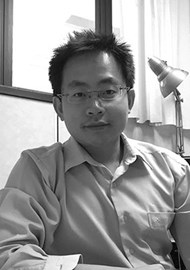Open source or crowd-sourcing and crowd-collaboration are concepts almost always associated with software and public online projects such as Wiki project. Never had I imagined that my team would apply the same principle in ophthalmology. Just less than a month ago, the world’s first open source smartphone retinal imaging device known as OphthalmicDocs Fundus (see Figure 1) was released online.

Figure 1: OphthalmicDocs Fundus. The world’s first open source smartphone retinal imaging device. The top right picture shows a retinal detachment, bottom right picture shows a branch retinal vein occlusion.
Within five days, more than 30,000 people flocked to the site with over a thousand downloads. The OphthalmicDocs Fundus is a device designed by OphthalmicDocs to turn a smartphone into a retinal camera capable of achieving up to 40 degree view of field. It is an initiative set out by our team to fight preventable blindness by providing free and affordable ophthalmic equipment in developing countries.
It all started a year ago. We wanted to create an affordable fundus camera which can be used for diagnostic, screening and tele-consultation purposes. Our team decided to create an affordable, accessible and accurate smartphone fundus camera. Affordability is easily achieved with the use of low cost material and optical lenses. For accuracy, we are running a pilot trial comparing retinal images taken with the device to those of a standard fundus camera. Initial results are promising; common retinal diseases such as diabetic retinopathy, retinal detachment and macular degeneration can be detected with the device. However, accessibility remains a challenge. We wanted to create a device that could potentially reach millions of healthcare providers all around the world especially those living in the developing countries where financial constraint limits the access to conventional ophthalmic diagnostic equipment.
A thorough review was conducted to examine how projects like Google Cardboard were so successful. Google Cardboard is a project backed by Google with the aim of making virtual reality an experience that everyone around the world could enjoy and experience. The blueprint is freely available online, anyone can make one. They even make the specification and drawings free to manufacturers who then mass produce it, making them cheaply available for those who do not have the time to make one.
The concept is appealing. We applied it to our first project, the OphthalmicDocs Fundus. The device requires a smartphone and a 20 dioptre lens, which is one of the most widely available lenses in any eye clinic around the world. The blueprint is made freely available online. We wanted to take a step further, we created a submission platform so anyone with knowledge in 3D designs can download the blueprint for modification and improvement and re-submit it back to the community. The final designs are streamlined for 3D printing. Anyone could just download the files and 3D print a fundus camera locally. For those who does not own a 3D printer, they can access one through 3DHubs.com where over 18000 printers are connected worldwide. A healthcare provider can just choose a 3D printer nearest to his or her location and get it printed locally.

Figure 2: The OphthDocs Eye App. An open source multifunction mobile application. It comes with an electronic patient management system, a variety of vision tests and ocular image acquisition capabilities.
The success of our first device have got us excited. We understood the importance of hardware and software integration. And thus, OphthDocs Eye App was born. It is an open-source multifunction app that offers electronic patient medical records, a huge variety of vision tests and ocular image acquisition modes. With an app and a couple of external adapters, a healthcare provider literally has the entire eye clinic in the palm of his hand. It is useful not just to ophthalmologists but to primary care physicians who can now assess their patients’ eyes accurately in an affordable and accessible manner. Being able to perform all the basic eye examinations accurately in a non-eye clinic setting gives the physician a huge advantage, shortening the time of diagnosis and improving patient outcome. The ability to photo-document the ocular diseases makes it even easier when consultation is needed.
Because the system is used in conjunction with a smartphone, it also shares access to the camera, telecommunication and wireless transmission capabilities, making it an ideal tool for telemedicine. This proven concept may well be a solution to the difficulty faced by healthcare providers in resource limited regions where access to affordable eye equipment is a major challenge.
Acknowledgement
The author would like to thank Dr Graham Wilson for his continuous clinical support and supervision, Benjamin O’Keeffe for his business management knowledge, and Daniel Dillen and Hanna Eastvold-Edwins for their technical knowledge and contribution in the project.
COMMENTS ARE WELCOME





